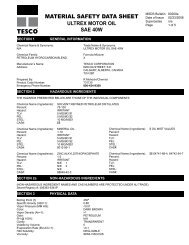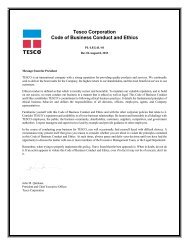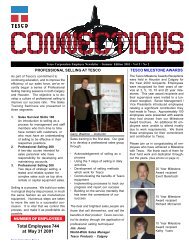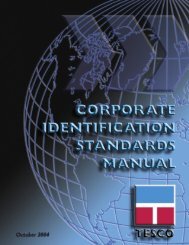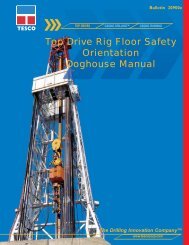Reconciliation of Non-GAAP Measures September 30, 2008
Reconciliation of Non-GAAP Measures September 30, 2008
Reconciliation of Non-GAAP Measures September 30, 2008
You also want an ePaper? Increase the reach of your titles
YUMPU automatically turns print PDFs into web optimized ePapers that Google loves.
Adjusted EBITDA (as defined below)<strong>Reconciliation</strong> <strong>of</strong> <strong>Non</strong>-<strong>GAAP</strong> <strong>Measures</strong><strong>September</strong> <strong>30</strong>, <strong>2008</strong>(in millions <strong>of</strong> U.S. $)TrailingTwelveMonthsYear Ended December 31,Ended2005 2006 2007 09/<strong>30</strong>/08Net Income $ 7 $ 31 $ 32 $ 47Income Taxes 6 23 10 16Depreciation and Amortization 18 22 27 31Net Interest expense 2 3 3 5Stock Compensation Expensenon-cash4 6 7 6Adjusted EBITDA $ 37 $ 85 $ 79 $ 106Our management evaluates Company performance based on non-<strong>GAAP</strong> measures, <strong>of</strong> which a primary performancemeasure is EBITDA. EBITDA consists <strong>of</strong> earnings (net income or loss) available to common stockholders before interestexpense, income tax expense, non-cash stock compensation, non-cash impairments, depreciation and amortization and othernon-cash items. This measure may not be comparable to similarly titled measures employed by other companies and is nota measure <strong>of</strong> performance calculated in accordance with <strong>GAAP</strong>. EBITDA should not be considered in isolation or assubstitutes for operating income, net income or loss, cash flows provided by operating, investing and financing activities, orother income or cash flow statement data prepared in accordance with <strong>GAAP</strong>.We believe EBITDA is useful to an investor in evaluating our operating performance because:• it is widely used by investors in our industry to measure a company's operating performance without regard toitems such as net interest expense, depreciation and amortization, which can vary substantially from company tocompany depending upon accounting methods and book value <strong>of</strong> assets, financing methods, capital structure andthe method by which assets were acquired;• it helps investors more meaningfully evaluate and compare the results <strong>of</strong> our operations from period to period byremoving the impact <strong>of</strong> our capital structure (primarily interest) and asset base (primarily depreciation andamortization) and actions that do not affect liquidity (stock compensation expense) from our operating results; and• it helps investors identify items that are within our operational control. Depreciation and amortization charges,while a component <strong>of</strong> operating income, are fixed at the time <strong>of</strong> the asset purchase in accordance with thedepreciable lives <strong>of</strong> the related asset and as such are not a directly controllable period operating charge.Our management uses EBITDA:• as a measure <strong>of</strong> operating performance because it assists us in comparing our performance on a consistent basis asit removes the impact <strong>of</strong> our capital structure and asset base from our operating results;• as one method we use to evaluate potential acquisitions;• in presentations to our Board <strong>of</strong> Directors to enable them to have the same consistent measurement basis <strong>of</strong>operating performance used by management;• to assess compliance with financial ratios and covenants included in our credit agreements; and• in communications with investors, analysts, lenders, and others concerning our financial performance.
Net Debt to Book Capitalization (as defined below)As <strong>of</strong>09/<strong>30</strong>/08Current Portion <strong>of</strong> Long-Term Debt $ 10Long-Term Debt 44Less: Cash and Cash Equivalents (8)Net Debt $ 46Shareholders’ Equity $ 357Add: Net Debt 46Book Capitalization $ 403Net Debt to Book Capitalization 11%Net debt is calculated by subtracting cash and cash equivalents from the sum <strong>of</strong> long term debt plus the current portion <strong>of</strong>long term debt. Net debt to book capitalization is calculated by dividing net debt by the sum <strong>of</strong> net debt plus shareholders’equity.




